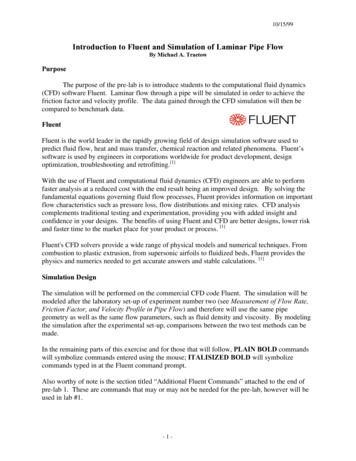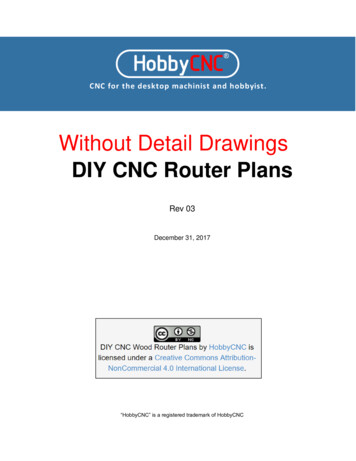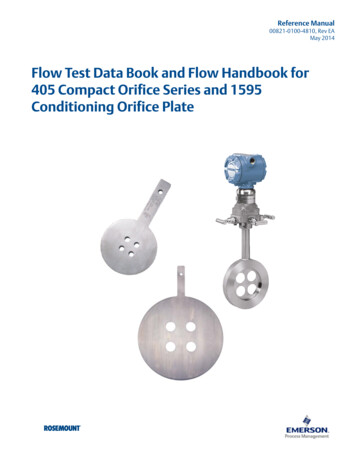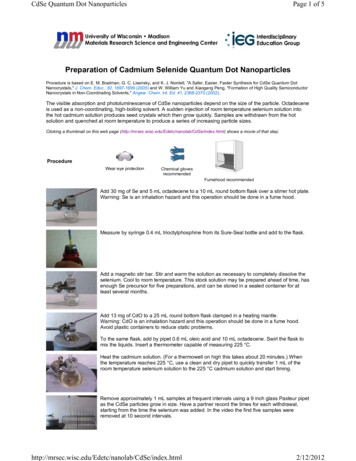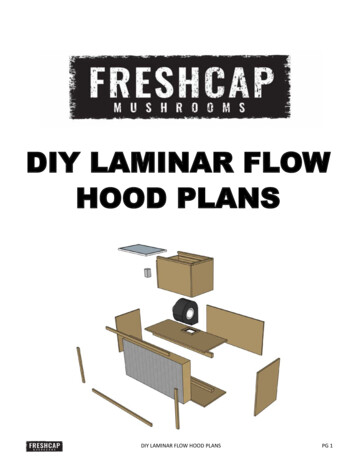
Transcription
DIY LAMINAR FLOWHOOD PLANSDIY LAMINAR FLOW HOOD PLANSPG 1
So, you wanna build a flow hood?This document outlines the build plans for a 2’ x 4’ Laminar Flow Hood, including requiredmaterials and tools, as well as a step by step guide to assembling the cabinet.For this build, I used a 24” x 48” Astrocel 1 Filter and a Dayton 1TDU2. For instructions onhow we specified this filter/fan combination, be sure to check out our YouTube video “DIYFlow Hood Part 1: Design.”If you are using your own filter/fan combinations, you can still use this as a guide for howto construct your box, just adjust the dimensions to what will work for your fan and filter.NOTE: I did my best to ensure that everything in these build plans is as accurate as possible- but be sure to use your own discretion when building your cabinet. If you see anyerrors, or ways to improve these build plans, be sure to let me know!Also, use caution when wiring your fan. Incorrect wiring could be dangerous. If you areuncomfortable wiring up your fan, please consult with an electrician. I am not an electrician, so even though I wired up the fan as described in the wiring diagram, I assumeno liability for these wiring instructions.DIY LAMINAR FLOW HOOD PLANSPG 2
MATERIALS AND TOOLSFILTER AND FANHEPA Filter(1) AstroCel 1 HEPA Filter 24” x 48” x 5-7/8”, Particle Board Frame, 99.99% Efficient @ 0.3 micrometer.Blower Fan(1) Dayton 1TDU2 Squirrel Cage Blower Fan (1202 CFM 1390 RPM)Pre-Filter(1) 16” x 25” x 1” Filtrete Furnace FilterCONSTRUCTION MATERIALS(2) Sheets 4’ x 8’ x ¾” Plywood (any plywood will do, smooth plywood like “Shop Birch” is best)(1) 2” x 3” x 8 ft lg (could also use standard 2” x 4”)(1) Box 1-5/8”” wood screws(2) ¼” Carriage Bolts(1) Tube Wood Glue(1) Tube Clear Silicone(3) ft length of door frame Weather StrippingELECTRICAL(1) 14 Gauge Extension Cord and about 1 ft of armored cable(1) Utility Box, utility box cover, toggle switch(1) electrical tape, marrettesSUGGESTED TOOLS Circular Saw with Guide or Table Saw for cutting plywood Power Drill, bit set for pre-drilling holes Jig Saw for fan outlet hole Clamps for holding box during construction Caulking gun, sand paper or power sander Measuring tape, square, pencil, utility knifeDIY LAMINAR FLOW HOOD PLANSPG 3
BUILDING A FLOW HOOD STEP BY STEPBuilding this laminar flow hood can be broken down into 5 basic steps:1. Constructing the filter housing and plenum.2. Installing the fan.3. Constructing the top box for the prefilter.4. Wiring the fan and switch.5. Installing filter and sealing box.1. CONSTRUCTING THE FILTER HOUSINGThe filter housing is the main structure of the flow hood. It holds the filter in place, and provides a“plenum” or air space behind the filter to build pressure and help with laminar flow. It needs to besolidly built, and provides the strength to hold a large blower fan and withstand vibration.This flow hood is built using 3/4” thick “shop birch”, which provides a finished and clean look. Youmay have to seek this out from a specialty wood supplier. You can also use sanded plywood, whichis commonly available at Home Depot and similar retailers, although it is more expensive. Anothermuch cheaper option is standard plywood, although this will have a rough finish.DIY LAMINAR FLOW HOOD PLANSPG 4
Step 1:Cut the 4 pieces that make up the main cabinet. These first four cuts could be cut from 1 sheet.This includes the bottom, the sides and the top. (the back will be added at the end of the build).The top and bottom piecesshould be cut at 24”20" x 48”. Thetop piece will eventually havea hole cut in for the fan.The two side pieces should becut at 25.5” x 20 ”.Using sanding paper or an electric sander, smooth out all the edges of the plywood. A smoothedge will ensure a better fit.DIY LAMINAR FLOW HOOD PLANSPG 5
Step 2:Cut the 2 x 3 in half, and fasten it to the bottom and top pieces to serve as a backing for the filterand to provide structural support. Fasten the 2 x 3 to the plywood with wood screws.Bottom piece should have the 2” x 3” withthe wide side down, placed 6-1/8” back fromthe front. Fasten together with 1-1/2” woodscrews through the back of the plywood.Top piece should have the 2” x 3” with the narrowside against the plywood, placed 6-1/8” back from thefront. Fasten together with 1-1/2” wood screwsthrough the back of the plywood.DIY LAMINAR FLOW HOOD PLANSPG 6
Step 3:Attach the side pieces with wood glue and 1.5 inch wood screws. If you have long clamps, use them to holdthe pieces in place as you are screwing it in. It is important to have the main cabinet square in order toproperly fit the filter and the back piece.Step 4:Before proceeding, check to see if the filter fits. It should be snug, but shouldn’t be forced in. You also don’twant air gaps around the filter, since that will allow for air leakage.Step 5:Cut the hole out of the top piece in order to install the fan. Mark out the correct location, drill four pilotholes, and cut it out with a jig saw. Sand the edges with sandpaper or a sanding block.Filter on this side.DIY LAMINAR FLOW HOOD PLANSPG 7
2. INSTALLING THE FANThe Dayton 1TDU2 does not have a mounting flange, and does not come with mounting hardware. However, it is pretty easy to use plywood, weather stripping, carriage bolts, and a 1/4” plywood shim to solidlymount the fan.Step 1:Install the weather stripping around the top hole. This is used to seal the space between the outlet of thefan and the top of the box, preventing air leakage. There are many ways that you can do this, so feel freeto get creative here.Pinch the weather stripping between the topbox and the 3/4” x 3/4” plywood strips. Fastenthe strips to the top of the box with woodscrews.Once the strips are installed, test fit the fan inthe hole. It should tight, with minimal chancesfor air leakage. If required, you can run a beadof silicon around the edge of the strips oncethe fan is installed.DIY LAMINAR FLOW HOOD PLANSPG 8
Step 2:Mount the fan by inserting it into the hole and placing a 1/4” shim under the back of the fanfor additional support. You may need slighty different sized shim, so use what works to fill thegap. You could also use cardboard for this.You should also install 1/4” carriage bolts through the plywood strips on both sides of the fan. Start bydrilling a hole in the middle of the plywood strip, right through the outlet of the fan. Tighten the bolt,but do not overtighten, as the plywood strips have a chance of cracking. These bolts help to furthersupport the fan, and ensure a solid installation.DIY LAMINAR FLOW HOOD PLANSPG 9
2. CONSTRUCTING THE PRE-FILTER BOXThe purpose of the pre-filter is to remove the larger particles, dust, and contaminates in the air, andwill extend the life of your more expensive HEPA filter.You could just slap a filter to the inlet of the fan, but building a box makes it look cleaner, makes iteasier to change the pre-filter, and provides a structure to hold the switch.Step 1:Cut the main pieces of plywood for the top box, and sand the edges until smooth.DIY LAMINAR FLOW HOOD PLANSPG 10
Step 2:Assemble the pieces together using wood screws. This box provides no structural support other thanholding the filter, so it doesn’t need to be as solid as the main box. You could even consider makingit out of thinner plywood, 1/2” would be plenty strong. We used 3/4” Shop Birch, just because wealready had two sheets for the rest of the box. Also, it looks nice :)DIY LAMINAR FLOW HOOD PLANSPG 11
Step 3:Cut the pieces for the rails, and attach to the inside and top of the box in order to provide a“track” for the pre-filter.Step 4:Using wood screws, attach the support rails to the filter box. Test that the furnace filter fits andthat it slides easily in and out of the track.DIY LAMINAR FLOW HOOD PLANSPG 12
Step 5:Attach the pre-filter box to the top of the main cabinet. You can either use wood screws from theinside of the cabinet, or use “l-brackets” to fasten it from the top. If you are screwing from the inside of the cabinet, remember that you won’t be able to remove it later without first removing thefilter or the back panel of the cabinet.DIY LAMINAR FLOW HOOD PLANSPG 13
4. WIRING THE FAN AND SWITCHNOTE: I wired the fan according to the diagram on the side of the blower, which I will repeat here. Keep in mind that electricitycan be dangerous, and wiring a fan wrong could cause electric shock or fires. I am not an electrician, and take no liability forthe wiring of the fan. If uncomfortable with this step, please consult a qualified electrician.The Dayton 1TDU2 does not come with an outlet that can be plugged into the wall, or a switch, so bothof these components need to be installed.Step 1:Using a 1/2” hole wood bit, drill a hole through the side of the pre-filter box, in the center of where theswitch is to be installed.Step 2:Take about 1 ft of armored cable and wire it to the fan according to the following 115V wiring diagram.Use marrettes, and wrap in electrical tape to ensure tight, solid connections. Once wired up, bundle upand fit into the junction box on the side of the blower. Ensure that the grounding wire is also connected.DIY LAMINAR FLOW HOOD PLANSPG 14
Step 3:Cut off the female end of a 14 gauge extension cord and strip the insulation back to expose thewires. Instead of using a extension cord, you could also just make up your own plug, but the extension cord is generally easier and might even be more cost effective.Step 4:Mount the junction box for the switch, pull the cable through and wire up the switch. Again, if youare unfamiliar with how to do this, it might be best to seek out a qualified electrician. Ensure thatyou properly ground the wiring as well. Install the faceplate cover on the switch. If you like, youcan install a hook to the side of the box to wrap up the remaining electrical cord.The fan should now be wired up and ready to be plugged in. Before moving on to finishing the install, the fan should be tested to ensure it runs smooth.DIY LAMINAR FLOW HOOD PLANSPG 15
5. INSTALL FILTER AND SEAL BOXNow that the main box is built and the fan is installed, you can install the filter and seal the box. The mainfilter has a gasket on the “downstream” side. In order to seal the box and hold the filter in place, plywoodstrips need to be mounted to the front of the box. Keep in mind that the fins on the filter are quite delicate,so be careful not to damage them.Step 1:Cut the strips to length, and sand smooth. The need to be1.5” wide in order to properly hold the filter in the frame.DIY LAMINAR FLOW HOOD PLANSPG 16
Step 2:Insert the filter and screw the strips to the front face of the flow hood. Pre-drill all the holes to preventcracking. These strips should not be glued, so that you can easily remove them if you ever need tochange the filter. The strips should form a tight seal with gasket that is on the “downstream” side of thefilter.Step 3:The final step is to install the back panel. Before you do that though, take time to vacuum outthe inside of the box, and remove any sawdust or debris. Also, check to ensure there is a goodseal between the inside of the box and the filter, and fill any gaps with silicon.Cut the back panel to fit the inside dimensions of the box, which should be 24” x 48 “.DIY LAMINAR FLOW HOOD PLANSPG 17
Step 4:In order to make installing the back panel easier, install some strips 0.75” back from the outside edge, justto provide something to push against when inserting the plywood.Install the back panel, and fasten with wood screws around the outside of the box.To complete the install, run a bead of silicon around the back panel to give it an air-tight seal.DIY LAMINAR FLOW HOOD PLANSPG 18
Done.That’s it! You now have a sweet flow hood for mycological work.Keep in mind that this thing is quite heavy, so make sure you have a truck and acouple people to move it where it needs to go.If there are any things missing from these build instructions, or you have any suggestions to makethis better, be sure to let me know!Enjoy your hood!DIY LAMINAR FLOW HOOD PLANSPG 19
DIY LAMINAR FLOW HOOD PLANS PG 4 BUILDING A FLOW HOOD STEP BY STEP Building this laminar low hood can be broken down into 5 basic steps: 1. Construcing the ilter housing and plenum. 2. Installing the fan. 3. Construcing the top box for the preilter. 4. Wiring the fan and switch. 5. Installing ilter and sealing box. 1. CONSTRUCTING THE FILTER HOUSING
